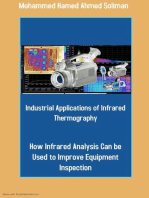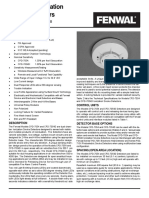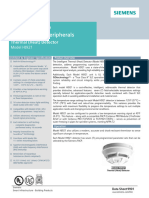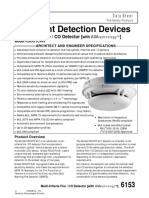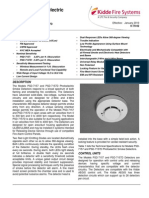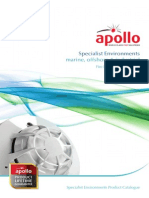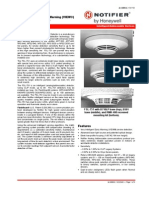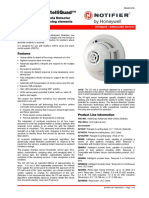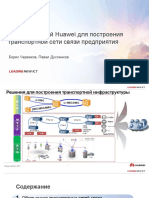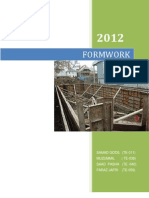2) OP921 - Optical Smoke Detector - Siemens
2) OP921 - Optical Smoke Detector - Siemens
Uploaded by
Mosin Bin MahammedCopyright:
Available Formats
2) OP921 - Optical Smoke Detector - Siemens
2) OP921 - Optical Smoke Detector - Siemens
Uploaded by
Mosin Bin MahammedOriginal Description:
Copyright
Available Formats
Share this document
Did you find this document useful?
Is this content inappropriate?
Copyright:
Available Formats
2) OP921 - Optical Smoke Detector - Siemens
2) OP921 - Optical Smoke Detector - Siemens
Uploaded by
Mosin Bin MahammedCopyright:
Available Formats
Data Sheet
Intelligent Detection Devices
Photoelectric Smoke Detector
Model OP921
ARCHITECT AND ENGINEER SPECIFICATIONS
Compatible with Siemens Model H-series devices on the same loop (with Cerberus PRO
fire-alarm control panels [FACPs] or FireFinder XLS FACPs)
Compatible with Model 8720 / DPU (device programmer / loop tester)
Utilizes advanced microprocessor-based signal processing
Extended temperature and humidity operating range
Each detector is self-testing:
Self monitored for sensitivity within UL Listed limits
Complete diagnostics performed every 10 seconds
Polarity insensitive utilizing SureWireTM technology
Compatible with Model DB-11series mounting bases
Tri-color detector-status LED with 360 viewing
Field-selectable application sensitivity profiles
Remote sensitivity-measurement capability
Utilizes advanced signal processing
Superior EMI / RFI immunity
RoHS compliant
Automatic environment compensation
UL268A Listed [for direct air-duct use],
ULC Listed; FM (#3230, 3210) and CSFM
#
( 7272-0067:0258) Approved
Product Overview
The Photoelectric Smoke Detector (Model OP921) uses
state-of-the-art microcontroller circuitry and surfacemount technology for maximum reliability. Model
OP921 incorporates an optical sensor using a lightscattering detection principle. The device utilizes
advanced software algorithms to analyze the signals,
and provides highly stable and accurate smoke
detection.
Further, Model OP921 uses state-of-the-art
microprocessor circuitry with error check; detector selfdiagnostics, and supervision programs.
Field-Device Programmer / Test Unit
Model OP921 is compatible with the Siemens fielddevice programmer / test unit (Model 8720 / DPU),
which is a compact, portable, menu-driven accessory
for electronically programming and testing detectors
easily and reliably.
Cerberus PRO
Fire Safety Products
Answers for infrastructure
Model 8720 / DPU eliminates the need for cumbersome,
unreliable mechanical programming methods, such as dials
or switches, and reduces installation and service costs by
electronically programming and testing the detector prior to
installation.
For proper operation of the field-device programmer / test
unit, the technician selects the accessorys program mode,
and enters the desired address. In turn, Model 8720 / DPU
automatically sets and verifies the address, as well as tests
the detector. When in the test mode, Model 8720 / DPU will
perform a series of diagnostic tests without altering the
address or other stored data, allowing technicians to
determine if the detector is operating properly.
Model 8720 / DPU operates on AC power or rechargeable
batteries, providing flexibility and convenience in
programming and testing equipment from practically any
location.
9902
Photoelectric Smoke Detector
Product Overview (continued)
Model 8720 / DPU operates on AC power or rechargeable
batteries, providing flexibility and convenience in
programming and testing equipment from practically any
location.
Model OP921 is a plug-in, two-wire and addressable
photoelectric smoke detector. Model OP921 is
Underwriters Laboratories Listed [ UL268A Listed for
direct in-air duct usage].
Each detector consists of a dust-resistant photoelectric
chamber and microprocessor-based electronics with a
low-profile plastic housing. Every Model OP921 fire
detector is shipped with a protective dust cover:
1
1.
2.
Dust cover
Smoke detector
Operation
Model OP921 is a wide-spectrum, photoelectric smoke
detector incorporating an infrared light-emitting diode
(IRLED), and infrared light-sensing photodiode. Under
normal conditions, light transmitted by the LED is
directed away from the photodiode and scattered
through the smoke chamber in a controlled pattern.
The smoke chamber is designed to manage light
dissipation and extraneous reflections from dust particles
or other non-smoke, airborne contaminants in such a
way as to maintain stable, consistent detector operation.
When smoke enters the detector chamber, light emitted
from the IRLED is scattered by the smoke particles, and is
received by the photodiode:
1. Labyrinth
2. Optical transmitter
3. Optical receiver
s Industry, Inc.
Building Technologies Division
Sensitivity Settings
Application Parameter Sets
Model OP921 provides four (4) pre-programmed
sensitivity parameter sets that can be selected by the
FACP to match the expected application or
environmental conditions:
Sensitive
Standard
Robust
Air-duct
Sensitive: This application parameter set is practically
suitable for areas where few misleading sources of false
alarm are present, and is appropriate where priority is
given to detecting open fires as soon as possible (e.g.
typically a clean application with controlled
environmental conditions.)
Standard: This application parameter set is practically
apt for normal office, hotel-lobby-type applications,
and is the default setting.
Robust: This application parameter set offers
improved resistance to false alarms in areas where
misleading sources, such as cigarette smoke or exhaust
fumes, may cause a nuisance alarm.
Air-Duct: This application parameter set is used when
the detector is used a UL268A (D I) compliant direct inair duct application without a duct housing.
Model OP921 does not require a field sensitivity test.
Model OP921 is UL Listed as a self-testing device and
complies with NFPA 72 as a self monitoring detector
and control panel arrangement. This parameter set is
also used when Model OP921 is used in air-duct
housings (Models FDBZ492 and FDBZ492-HR).
The visible LED flashes green every 10 seconds to
indicate communication with the FACP, and to notify
Model OP921 has passed its self-test. Should Model
OP921 sense a fault or failure within its system, the LED
will flash amber, and the detector will transmit the data
to the FACP.
A quick visual inspection is sufficient to indicate the
condition of Model OP921 at any time. If more detailed
information is required, a printed report can be
provided from the compatible FACP, indicating the
status and settings assigned to each individual detector.
When Model OP921 moves to Alarm mode, the detector
will flash red and continue flashing until the system is
reset at the FACP. At that same time, any user-defined,
system-alarm functions programmed into the system
are activated.
Model OP921 contains a tri-color LED indicator, capable
of flashing any one (1) of three (3) distinct colors:
green, yellow, or red. During each flash interval, the
microprocessor-based detector monitors the following:
Cerberus PRO
Operation (continued)
Smoke sensitivity is within the range
indicated on the nameplate label
Smoke in its sensing chamber
Internal sensors and electronics are functional
Based on the monitoring results, the LED indicator
flashes the following colors based on the following
conditions:
Flash
Flash
Color
Green*:
Yellow:
Red:
No Flash:
Condition
Interval
(in seconds)
Normal supervisory operation.
Smoke sensitivity is within rated
limits.
Detector is in trouble and needs
replacement.
Alarm condition.
Detector is not powered.
10
4
1
* LED can be turned OFF.
Please follow the corresponding description of the panel used.
A quick, visual inspection is sufficient to indicate the condition of
the detector at any time. If more detailed information is required,
a printed report can be provided from the respective Cerberus PRO
FACP that indicates the status and settings assigned to each
individual detector.
Installation
All Model OP921 detectors use a surface-mounting base,
Model DB-11 or Model DB-11E, which mounts on a 4-inch
octagonal, square or single-gang electrical box. The base
utilizes screw-clamp contacts for electrical connections and
self-wiping contacts for increased reliability.
Model OP921 can be applied within the maximum 30feet center spacing (900 sq. ft. areas), as referenced in
NFPA 72. This application guideline is based on ideal
conditions specifically, smooth ceiling surfaces,
minimal air movement, and no physical obstructions
between potential fire sources and the actual detector.
Do not mount detectors in close proximity to
ventilation or heating and air-conditioning outlets.
Exposed joints or beamed ceilings may also affect safe
spacing limitations for detectors.
Should questions arise regarding detector placement,
observe NFPA 72 guidelines. Good fire-protection
system engineering and common sense dictate how
and when fire detectors are installed and used.
Contact your local Siemens Fire Safety distributor or
sales office whenever you need assistance applying
Model OP921 in unusual applications. Be sure to
follow NFPA guidelines and UL Listed / ULC Listed
installation instructions included with every Siemens
Fire Safety detector and local codes as for all fireprotection equipment.
Technical Data
Operating
Temperature
Range:
+32F (0C) to 120F (49C)
Relative Humidity:
0 95%; non-condensing
Air Pressure:
Air Velocity:
No effect
0 4,000 ft. / min (0-20m / sec)
The Model DB-11 base can be used with the optional Model LK-11
detector locking kit, which contains 50 detector locks and an
installation tool to prevent unauthorized removal of the detector
head. Model DB-11 has decorative plugs to cover the outermounting screw holes.
Input Voltage Range:
Model OP921may be installed on the same initiating circuit
with the Siemens Model H-series detectors [when used with
the Cerberus PRO FACPs]
Maximum Spacing:
30-foot centers (900 sq. ft.),
per NFPA 72
Detector Weight:
0.317 lbs. (0.144 kg.)
Model HFP-11
Model HMS-series manual stations
Model HTRI-series interfaces
Model HCP output-control devices
Model HZM-series of addressable,
conventional zone modules
16VDC 30VDC
Alarm Current (max.):
280A
Standby Current (max.):
280A, max. (average)
Mechanical Protection Guard:
UL Listed / ULC Listed
[with ST I Guard Model ST I-9604]
Application Data
Installation of Model OP921detectors requires a two-wire
circuit. In many retrofit cases, existing wiring may be used.
T-tapping is permitted only for Style 4 (Class B) wiring.
Model OP921 is polarity insensitive, which can greatly reduce
installation and debugging time.
s Industry, Inc.
Building Technologies Division
Cerberus PRO
Mounting Diagram
Details for Ordering
Dimensions
Model
OP921
Part
Number
Description
S54320-F4-A2 Photoelectric Smoke Detector
DB-11
500-094151
Detector Mounting Base
DB-11E
500-094151E Detector Base {small}
DB2-HR
S54320-F12-A1 Relay Base
Remote Alarm Indicator:
RL-HC
500-033230
4 octagon-box mount, red
Remote Alarm Indicator:
RL-HW
500-033310
single-gang box mount, red
FDBZ492
S54319-B22-A1 Addressable Air-Duct Housing
FDBZ492-HR S54319-B23-A1 Addressable Air-Duct
Detector with Relay
LK-11
500-695350 Base Locking Kit
Detector Compatibility Table
Model
Data
Sheet
Number
Description
STI -9604
6300
FireFinder XLS (system overview)
FC901
9813
50-point panel
FC922
9815
252-point system (networkable)
FC924
9815
504-point system (networkable)
FV922
9821
252-point intelligent voice
communication system
Model
FV922
9821
504-point intelligent voice
communication system
DB-11C
s Cerberus PRO
Siemens Industry, Inc. Building Technologies Div.
8 Fernwood Road Florham Park, NJ 07932
Tel: (973) 593-2600 Fax: (908) 547-6877
Web: www.USA.Siemens.com/Cerberus-PRO
Building Technologies Division
SII Fire Saf et y
[Printed in U.S.A ]
STI Mechanical Protection Guard
See: www.ST I-USA.com for further details on ordering
Model ST I-9604.
In Canada, order:
Part
Number
Description
500-095687 Detector Mounting Base
for ULC (Listed)
NOTICE The information contained in this data-sheet document is intended only as a summary,
and is subject to change without notice. The devices described here have specific instruction sheets
that cover various technical, limitation and liability information.
Copies of these instruction sheets and the General Product Warning and Limitations document,
which also contains important information, are provided w ith the product and, are available
from the Manuf acturer.
Informat ion cont ained in t hese document s should be consult ed before specifying or using the
product. For further information or assistance concerning particular problems contact the Manufacturer.
March 2015 Supersedes sheet dated 11/2013
(Rev. 5)
You might also like
- MEAT by Logan MartinDocument92 pagesMEAT by Logan MartinAnonymous oZjtxANzcw100% (2)
- Industrial Applications of Infrared Thermography: How Infrared Analysis Can be Used to Improve Equipment InspectionFrom EverandIndustrial Applications of Infrared Thermography: How Infrared Analysis Can be Used to Improve Equipment InspectionRating: 4.5 out of 5 stars4.5/5 (3)
- R.C.C Pier Design of BridgeDocument42 pagesR.C.C Pier Design of BridgeMd BIN HASAN100% (1)
- Model OH921 Multi Criteria Fire Detector Data Sheet A6V10337771 Us enDocument4 pagesModel OH921 Multi Criteria Fire Detector Data Sheet A6V10337771 Us enWERMERMNo ratings yet
- Cerberus® PRO: Detectors and PeripheralsDocument4 pagesCerberus® PRO: Detectors and PeripheralsaskarNo ratings yet
- Cerberus® PRO: Detectors and PeripheralsDocument4 pagesCerberus® PRO: Detectors and PeripheralsShashish AshuNo ratings yet
- 4) OOH941 - High Sesitive ASA Smoke & HeatDocument6 pages4) OOH941 - High Sesitive ASA Smoke & HeatMosin Bin MahammedNo ratings yet
- 3 Oh921 PDFDocument4 pages3 Oh921 PDF'Jack Kevin Swayne LopezNo ratings yet
- SD Op921Document4 pagesSD Op921Mohammad FathiNo ratings yet
- Ntelligent Detection Devices: Multi-Criteria Fire Detector (With Asatechnology)Document6 pagesNtelligent Detection Devices: Multi-Criteria Fire Detector (With Asatechnology)Muhammad Azizi SubariNo ratings yet
- Siemens Photoelectric Smoke DetectorDocument5 pagesSiemens Photoelectric Smoke DetectorEngineering TFINo ratings yet
- Advanced Ionization Smoke Detectors: Protection SystemsDocument6 pagesAdvanced Ionization Smoke Detectors: Protection SystemsmareveyNo ratings yet
- Ntelligent Detection Devices: Data SheetDocument4 pagesNtelligent Detection Devices: Data SheetMazenabs AbsNo ratings yet
- Ntelligent Detection Devices: Cerberus® PRODocument6 pagesNtelligent Detection Devices: Cerberus® PROYousaf AliNo ratings yet
- Siemens Smoke Detector OOH941Document6 pagesSiemens Smoke Detector OOH941Engineering TFINo ratings yet
- HI921 Thermal Heat Detector Data Sheet - A6V10342764 - Us enDocument4 pagesHI921 Thermal Heat Detector Data Sheet - A6V10342764 - Us enAndrew PanjaitanNo ratings yet
- Advanced Ionization Smoke Detectors: Models CPD-7054 and CPD-7054DDocument4 pagesAdvanced Ionization Smoke Detectors: Models CPD-7054 and CPD-7054Dktty RMNo ratings yet
- HD Hi921Document5 pagesHD Hi921Mohammad FathiNo ratings yet
- Manual de Instalare Bariera IR DOP 6001 - ENGDocument14 pagesManual de Instalare Bariera IR DOP 6001 - ENGDorin SimioanaNo ratings yet
- DOR-4046-Manual de Instalare - ENGDocument8 pagesDOR-4046-Manual de Instalare - ENGmihai_gamaNo ratings yet
- DF 50934Document4 pagesDF 50934ayman abbasNo ratings yet
- A6V10323928Document4 pagesA6V10323928Amzad HussainNo ratings yet
- Gabinete Detector Ducto DNR - DST1,5Document2 pagesGabinete Detector Ducto DNR - DST1,5rodrigo munozNo ratings yet
- Detector Humo Direccionable D7050Document2 pagesDetector Humo Direccionable D7050Mario Javier CNo ratings yet
- A6V10350298 enDocument6 pagesA6V10350298 enCost RootsNo ratings yet
- DUR-4047 Manual de Instalare - ENGDocument11 pagesDUR-4047 Manual de Instalare - ENGDorin SimioanaNo ratings yet
- System Sensor DST1 Data SheetDocument8 pagesSystem Sensor DST1 Data SheetJMAC SupplyNo ratings yet
- 8A. FDAS - Presentation - IIEE-CRCSA 1st Technical Webinar - March 25, 2022Document61 pages8A. FDAS - Presentation - IIEE-CRCSA 1st Technical Webinar - March 25, 2022Nels OdrajafNo ratings yet
- FSC-851 IntelliQuad Multi-Criteria Det DN-60412Document2 pagesFSC-851 IntelliQuad Multi-Criteria Det DN-60412Anonymous Mw2nwE6AjNo ratings yet
- F 70 02 PSD 7157 Smoke DetectorDocument4 pagesF 70 02 PSD 7157 Smoke DetectorAkoKhalediNo ratings yet
- Gsti 9104Document2 pagesGsti 9104aditgroupNo ratings yet
- Ntelligent Detection Devices: Data SheetDocument6 pagesNtelligent Detection Devices: Data SheetMazenabs AbsNo ratings yet
- Advanced Photoelectric Smoke Detectors: FeaturesDocument8 pagesAdvanced Photoelectric Smoke Detectors: Featuresoscarninan100% (1)
- Detector 70-02 - Photo Smoke Detector Model CPD-7157 - 2010Document4 pagesDetector 70-02 - Photo Smoke Detector Model CPD-7157 - 2010DM2No ratings yet
- C 9104Document1 pageC 9104aditgroupNo ratings yet
- Fco-851 (A) Intelliquad™ Plus: Advanced Multi-Criteria Fire/Co DetectorDocument2 pagesFco-851 (A) Intelliquad™ Plus: Advanced Multi-Criteria Fire/Co DetectorfesterrNo ratings yet
- Depliant Iris Enea Inim 1.10 ENGDocument4 pagesDepliant Iris Enea Inim 1.10 ENGKnjigescribdNo ratings yet
- Gsti 9105Document2 pagesGsti 9105aditgroupNo ratings yet
- Sow N-1 FG System Rev. 1Document5 pagesSow N-1 FG System Rev. 1HashemAliHashemNo ratings yet
- Apollo Marinecatalogue2013 All Mr-LockedDocument0 pagesApollo Marinecatalogue2013 All Mr-LockedVictor ChuaNo ratings yet
- Panasonic Fire Alarm BrochureDocument24 pagesPanasonic Fire Alarm BrochureMolly0630100% (1)
- Safeair Carbon Monoxide Detector: Conventional Initiating Devices SecurityDocument4 pagesSafeair Carbon Monoxide Detector: Conventional Initiating Devices SecurityIBJSC.comNo ratings yet
- FSL 751Document4 pagesFSL 751Janmike GanabanNo ratings yet
- DOP 6001 Optical Beam Smoke Detector: POLON 4000 Interactive Fire Detection and Alarm SystemDocument14 pagesDOP 6001 Optical Beam Smoke Detector: POLON 4000 Interactive Fire Detection and Alarm SystemDani ChisNo ratings yet
- 1 Company and Product Presentation 11.2015-TP EngDocument95 pages1 Company and Product Presentation 11.2015-TP Engportocala12No ratings yet
- FG901 Detector Data SheetDocument2 pagesFG901 Detector Data SheetmohammadNo ratings yet
- Detector Fapt 851Document2 pagesDetector Fapt 851María Elena Huerta CarmonaNo ratings yet
- Edwards Signaling Smoke and Heat Detectors Application Bulletin PDFDocument44 pagesEdwards Signaling Smoke and Heat Detectors Application Bulletin PDFAhmed OmarNo ratings yet
- Fire Alarm Installation GuideDocument44 pagesFire Alarm Installation GuideRahul SrivastavaNo ratings yet
- Fire-Lite DST10 Data SheetDocument2 pagesFire-Lite DST10 Data SheetJMAC SupplyNo ratings yet
- BEAM1224 & BEAM1224S: Single-Ended, Reflected-Type Conventional Beam Smoke DetectorsDocument2 pagesBEAM1224 & BEAM1224S: Single-Ended, Reflected-Type Conventional Beam Smoke DetectorsWiro SablengNo ratings yet
- VESDA LaserPLUS Data SheetDocument4 pagesVESDA LaserPLUS Data SheetalvarochavezzNo ratings yet
- Edwards Fire Alarm EquipmentDocument45 pagesEdwards Fire Alarm EquipmentБахтияр ЮмачиковNo ratings yet
- Fsc-851 (A) Intelliquad™: Advanced Multi-Criteria Detector With Four Unique Sensing ElementsDocument2 pagesFsc-851 (A) Intelliquad™: Advanced Multi-Criteria Detector With Four Unique Sensing ElementsLogan Marquez AguayoNo ratings yet
- Fdklu001 PshaDocument2 pagesFdklu001 PshaGUDANG BERITA KITANo ratings yet
- Data Sheet enUS 2700120843Document3 pagesData Sheet enUS 2700120843Forward MyanmarNo ratings yet
- DetTronics GasDetector PIRECLDocument51 pagesDetTronics GasDetector PIRECLyasfin1990No ratings yet
- Serie 7100 Manual 9000-0447Document50 pagesSerie 7100 Manual 9000-0447Diego CortesNo ratings yet
- The Flamegard Series of Flame Detectors: Fast, Reliable Flame DetectionDocument4 pagesThe Flamegard Series of Flame Detectors: Fast, Reliable Flame DetectionSandika JayaputraNo ratings yet
- P P H H D D: Rocessor en Anced EtectionDocument4 pagesP P H H D D: Rocessor en Anced EtectionRomly FerlandoNo ratings yet
- Arduino Measurements in Science: Advanced Techniques and Data ProjectsFrom EverandArduino Measurements in Science: Advanced Techniques and Data ProjectsNo ratings yet
- G-Fence 3000 Wiring PrincipleDocument1 pageG-Fence 3000 Wiring PrincipleMosin Bin MahammedNo ratings yet
- SR 114HDocument1 pageSR 114HMosin Bin MahammedNo ratings yet
- Agrippa Pillow Alarm DatasheetDocument1 pageAgrippa Pillow Alarm DatasheetMosin Bin MahammedNo ratings yet
- 7) MTH-75-R-WP - Out Door Multi Candella Sounder StrobeDocument5 pages7) MTH-75-R-WP - Out Door Multi Candella Sounder StrobeMosin Bin MahammedNo ratings yet
- 10) Cerberus Remote SoftwareDocument2 pages10) Cerberus Remote SoftwareMosin Bin MahammedNo ratings yet
- 9) RL-HC - Remote LED Indicator PDFDocument2 pages9) RL-HC - Remote LED Indicator PDFMosin Bin MahammedNo ratings yet
- 8) HLI-M - Line Isolator ModuleDocument2 pages8) HLI-M - Line Isolator ModuleMosin Bin MahammedNo ratings yet
- 9) RL-HC - Remote LED IndicatorDocument2 pages9) RL-HC - Remote LED IndicatorMosin Bin MahammedNo ratings yet
- 3) DB11 Detector BaseDocument2 pages3) DB11 Detector BaseMosin Bin MahammedNo ratings yet
- .Access Control System ArchitectureDocument7 pages.Access Control System ArchitectureMosin Bin MahammedNo ratings yet
- Emlaq Al Sharq - Profile BroucherDocument8 pagesEmlaq Al Sharq - Profile BroucherMosin Bin MahammedNo ratings yet
- Art NoveauDocument47 pagesArt NoveauPia TiamzonNo ratings yet
- Transport NetworkDocument57 pagesTransport NetworkНиколай ТихоновNo ratings yet
- Subject Name: Microprocessor and Programming Model Answer: Important Instructions To ExaminersDocument40 pagesSubject Name: Microprocessor and Programming Model Answer: Important Instructions To ExaminersTasmia KhanNo ratings yet
- HP OpenView Operations For UNIXDocument198 pagesHP OpenView Operations For UNIXMiladin SiljanoskiNo ratings yet
- 6.chapter 03 33Document29 pages6.chapter 03 33Jenidal B. Mana-ayNo ratings yet
- 1-Span Cast-In-Place Concrete Box Girder Bridge Example CIPPTDocument104 pages1-Span Cast-In-Place Concrete Box Girder Bridge Example CIPPTalpyilmaz87No ratings yet
- NATIONAL BUILDING CODE-Important ClauseDocument5 pagesNATIONAL BUILDING CODE-Important ClauseSachin S Suvarna0% (1)
- FormwrkDocument16 pagesFormwrkSamad Godil100% (1)
- Safe Design StructuresDocument29 pagesSafe Design StructuresMyca QuizaNo ratings yet
- Van Der Lans Data Delivery PlatformDocument4 pagesVan Der Lans Data Delivery Platformfware28No ratings yet
- Seattle Public LibraryDocument18 pagesSeattle Public LibraryDaisy Rodriguez100% (2)
- P-660HW-T1 v3 - 1Document2 pagesP-660HW-T1 v3 - 1Alain Delon ProstNo ratings yet
- SAG ESB Platform FS Dec0Document2 pagesSAG ESB Platform FS Dec0Ananth K WilsonNo ratings yet
- National SeminarDocument2 pagesNational SeminarChristopher PreeceNo ratings yet
- XP 10MDocument2 pagesXP 10MAnonymous z1mdod8rcjNo ratings yet
- Plate No. 2: Analysis and Design of Flexural MembersDocument12 pagesPlate No. 2: Analysis and Design of Flexural MembersIrene B. QuiñonesNo ratings yet
- POLIFORM Wall SystemDocument3 pagesPOLIFORM Wall SystemTraistaru AndreaNo ratings yet
- DX DiagDocument15 pagesDX DiagglenNo ratings yet
- EN Vilnius Mini GuideDocument31 pagesEN Vilnius Mini GuideWiliam MantusNo ratings yet
- AirLive WT-2000R ManualDocument80 pagesAirLive WT-2000R ManualDjerviNo ratings yet
- 01 - General Tracker-1Document4 pages01 - General Tracker-1MAGED ELSADIGNo ratings yet
- Aws Iot MQTTDocument262 pagesAws Iot MQTTJordan RashevNo ratings yet
- CCTV Products Price List 12 January 2015 PDFDocument15 pagesCCTV Products Price List 12 January 2015 PDFKonikaHossainNo ratings yet
- Wireless Router ProjectDocument10 pagesWireless Router ProjectAshwini BaskaranNo ratings yet
- Sapfront DLL VersionDocument11 pagesSapfront DLL Versionsamir9952282706No ratings yet
- Crane Runway Beam Design - Beam Section Check Using CSA S16-14 Code-3Document4 pagesCrane Runway Beam Design - Beam Section Check Using CSA S16-14 Code-3sergiooiNo ratings yet
- World Travel Agency: GermanyDocument8 pagesWorld Travel Agency: GermanyAnonymous 27EhWKmhsaNo ratings yet
- HVAC Power Density: An Alternate Path To EfficiencyDocument6 pagesHVAC Power Density: An Alternate Path To EfficiencyCamilo Enrique Monroy CardenasNo ratings yet

